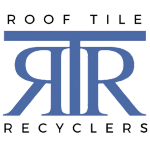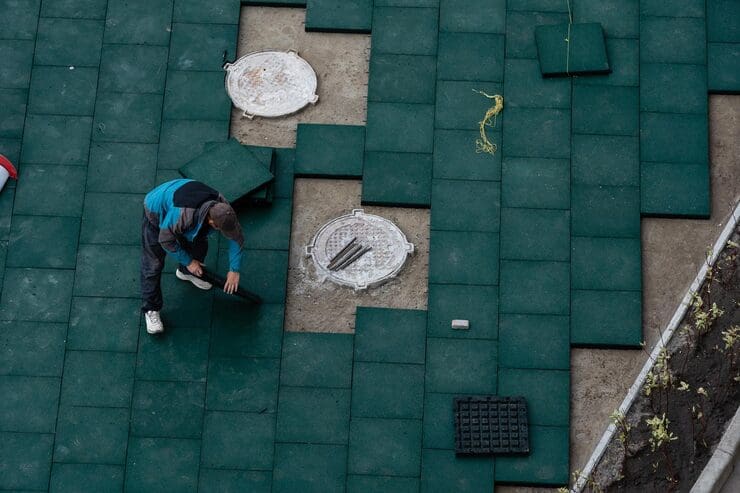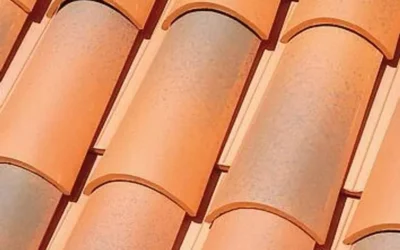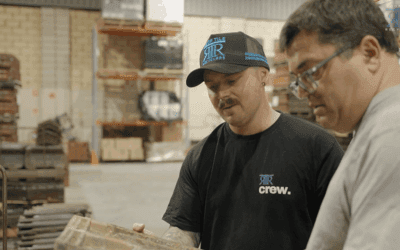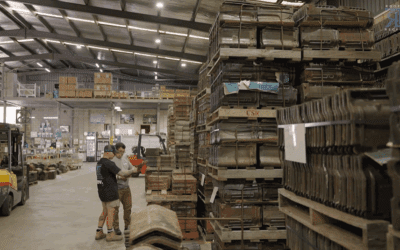Restoring a concrete tile roof can dramatically extend its lifespan, improve energy efficiency, and save thousands compared to a full replacement. Whether you’re restoring a full roof or just repainting aged tiles, concrete roof restoration is a smart, cost-effective solution for bringing your roof back to life. It’s especially relevant for older homes across Australia, where the tiles are still structurally sound but looking tired or weathered.
At Roof Tile Recyclers, we help homeowners and roofers source everything needed for a proper restoration, from rare replacement tiles to spray gear, pointing compounds, and coatings suited to Australia’s climate.
What Is the Cost to Restore Concrete Roof Tiles in Australia?
In 2025, most concrete roof tile restoration jobs range between $6,000 and $11,000 + GST, depending on your roof’s size, complexity, and condition. On average:
A 250m² single-storey roof at around a 22° pitch will cost $6,000–$7,000 + GST
A double-storey roof of the same size typically costs between $8,000 and $11,000 + GST
Smaller roofs (e.g., 110m²) may cost around $10,000, based on public forum quotes, especially where access or repairs are involved
These figures assume the tiles are in restorable condition and that the coating system includes a primer and two membrane coats, the standard in professional applications.
What Factors Affect the Price?
Several factors affect the total cost:
Roof pitch and access: Steeper roofs or ones with Dutch gables often require scaffolding, adding labour and safety costs.
Condition of the tiles: Cracked, porous, or fretting tiles will need to be swapped out. If your tile profile has been discontinued, recycled tile sourcing becomes essential.
Re-bedding or pointing: If your ridges need to be rebuilt or re-sealed, expect additional time and material costs.
Coating quality: A premium, UV-stable membrane (like Dulux Acratex) with mould resistance and colour retention will cost more but last significantly longer.
Region: Labour and delivery costs vary across Australia. Brisbane, for example, tends to be more competitive than the Sydney metro.
Restoration remains significantly more affordable than full re-roofing, and it’s often the smarter choice if your tiles are structurally sound.
If you’re repairing cracked or chipped tiles, using recycled or obsolete tile stock from our 150,000+ in-store inventory can cut material costs and preserve the look of your original roof.
Full Process of Concrete Roof Tile Restoration — Step by Step
Every proper restoration follows a clear sequence, and skipping steps risks peeling paint, poor adhesion, or water ingress. Here’s how the process typically unfolds on a concrete tile roof:
1. Site Assessment & Quote
A certified roofer will inspect the roof and identify issues like cracked tiles, failing mortar, and weak ridges. This stage also includes:
Measuring roof area and access points
Choosing colour and coating system
Providing a line-item quote with materials, PSI spec, and estimated days onsite
If you’re unsure of your tile type, our tile identification tool lets you send a photo for fast matching helpful if your tile has been discontinued.
2. High-Pressure Cleaning (3,000–4,000 PSI)
The restoration begins with a thorough pressure wash using professional-grade machines. Most use 3,000–4,000 PSI, though some teams use up to 5,000 PSI depending on buildup.
This step strips away:
Old coatings
Lichen, moss, and dirt
Oxidation layers
The result? A raw concrete surface is exactly what you want before priming. Gutters and downpipes are flushed and protected to avoid staining or clogging.
3. Repairs & Tile Replacement
Any damaged or missing tiles are replaced. This may include:
Cracked corners, chipped edges, or slipped tiles
Resealing valleys or replacing aged flashing
Fixing loose tiles along the hips or ridges
Where possible, recycled tiles are used to maintain a consistent colour and profile, especially useful for obsolete Bristile or Monier designs no longer in production.
4. Re-bedding & Flexible Pointing
If the original ridge bedding is cracked, loose, or missing entirely, it will need to be re-bedded with fresh mortar. Then, a modern polymer-based pointing compound is applied to seal the ridge caps and withstand future movement.
Unlike old sand-and-cement pointing, modern compounds remain flexible and don’t require weep holes, making them more durable under Australia’s thermal expansion conditions.
Re-bedding may add 1–3 days to the timeline, depending on the extent of deterioration.
How Long Does a Roof Tile Restoration Take?
The full restoration process from first contact to final coat typically takes 2 to 3 weeks, though actual time on-site is shorter.
PhaseEstimated TimeSite inspection & quote1–2 daysPlanning & material prep1–2 weeksOnsite restoration3–5 days (can extend to 7+ with repairs or weather)
Weather Buffers Matter
Dry weather is critical, especially between coats. Roof restorations in Brisbane or the Gold Coast often move faster in winter due to lower rainfall and cooler temperatures. In humid regions or coastal areas, drying time may stretch an extra day or two between primer and top coats.
It’s also worth noting that membrane coatings often have manufacturer-set drying times, and these should be followed closely to preserve warranty conditions.
Do You Need to Restore Your Concrete Roof? 5 Signs to Act On
Restoration isn’t just about improving how your roof looks; it’s about preventing leaks, water damage, and costly future repairs. Here are the most common signs your concrete tile roof is due for professional restoration:
Watermarks or brown stains on your ceiling
Daylight visible through the roof tiles from the attic or interior
Sagging ridge lines or dips in the roofline
Cracked or missing pointing on ridge caps
Tiles slipping or dislodging after storms
If you’re seeing any of these, acting early will almost always save money compared to waiting for leaks or structural damage. For full reroofing advice or qualified trades, you can get matched with a licensed roofer through our referral system.
Re-bedding vs Pointing – What’s the Difference?
Many homeowners confuse bedding and pointing, and while they work together, they’re very different parts of the ridge system:
ComponentFunctionDurationBeddingThe structural mortar that holds the ridge tile in place1–3 daysPointingThe visible outer layer that seals and finishes the ridge1 day
If your bedding is still intact and secure, only repointing may be required. But if ridge caps are shifting, cracked, or unstable, re-bedding will likely be necessary before new pointing is applied.
At Roof Tile Recyclers, we stock both traditional and flexible pointing compounds preferred by most roofers due to their movement tolerance and long-term adhesion. They also eliminate the need for weep holes, which were common with older cement systems.
Should You Restore or Replace a Concrete Tile Roof?
Restoration makes sense when your tiles are still structurally sound, but there are limits. Here’s a quick breakdown to help you decide:
ConditionRecommended ActionTiles are faded but intactRestorePointing or bedding is crackedRestore with repairsThe roof is leaking in multiple areasMay require inspectionTiles are fretting, porous, or crumblingReplaceRidge lines are sagging or bucklingReplace or re-frameRoof age 20–25+ yearsRestore (if the structure is sound)
If your home has terracotta tiles showing signs of fretting, or if you’re looking to reduce structural weight, a conversion to Colorbond roofing may be worth considering. A metal roof with blanket insulation can cut tile weight by 90% and improve thermal performance, but it comes at a higher upfront cost.
For homeowners who do decide to replace, RTR buys back reusable tiles through our tile buyback program, helping reduce landfill and support sustainable construction.
Restoring Around Solar Panels – What You Should Know
Solar panels can complicate a restoration project, but they don’t make it impossible. You have two main options:
Mask and spray around existing panels: Most painters will carefully coat underneath up to 100 mm using hand tools or spray shields.
Remove and refit the panels: This requires a licensed solar electrician and usually costs between $800–$1,200 + GST.
Where possible, it’s best to restore before panels are installed. It allows for even coating, no masking, and full access to all tiles. If solar is already installed, request at least 20 spare colour-matched tiles to store for future panel maintenance.
Warranties, Coatings & Finance — What to Expect
A high-quality roof restoration isn’t just about appearance; it should come with warranties and long-term performance.
10-year workmanship warranties are common across the industry
15-year coating warranties are available when applied by certified applicators (e.g., Dulux Acratex)
Penetrating primers and UV-stable top coats are standard in premium systems
At Roof Tile Recyclers, we supply restoration-grade coatings and flexible pointing products used by certified trades across Australia. While we don’t offer direct finance, it’s important to know that:
3rd-party “interest-free” plans like Humm or PayRight often include margin markups
Personal loans or home-loan redraws may offer a lower total cost
Always compare quotes and read the fine print, especially if warranty coverage depends on a specific coating system or application method.
Maintenance Tips After a Roof Restoration
Restoring a concrete tile roof is a smart investment, and a little maintenance will help you maximise its lifespan and protect your warranty.
Here’s a simple care plan:
Inspect your roof twice a year, ideally before autumn and spring
Clear debris from gutters, valleys, and behind solar panels
Soft wash any mould or algae buildup avoid DIY high-pressure washing on coated tiles
Check ridges and pointing after major storms or high winds
Avoid walking on the roof, especially if coated foot traffic can crack the membrane
If you notice cracks, bubbling paint, or discoloured patches, book a professional inspection early. Minor issues are easy to fix, but only if caught in time.
And always remember: accessing your roof is dangerous. Falls from height and accidental contact with live wiring are real risks. Use a licensed roofer with safety gear and insurance.
For reliable, local trades, our roofer referral tool connects you with qualified professionals near you.
Ready to Restore? Start with the Right Tiles and Tools
Restoring your concrete roof isn’t just about the paint; it’s about materials that last, workmanship you can trust, and tools that get the job done right.
At Roof Tile Recyclers, we support both homeowners and trades with:
Used and obsolete roof tiles for rare matches
Graco and Wagner spray equipment hire
Pointing compounds and coating systems for any job size
Roofer referrals and tile buybacks across NSW and beyond
Not sure what gear you need? We’ll guide you through it.Want to sell your old tiles? Get paid the same day.
Shop the range. Hire a machine. Get a match.
Start Here →
FAQ: Concrete Roof Tile Restoration (2025)
What is concrete roof tile restoration?A multi-stage process that involves cleaning, repairing, priming, and coating a tiled roof to restore appearance, durability, and weatherproofing without replacing the entire structure.
How long does a roof restoration take?The full process typically takes 2–3 weeks from quote to final inspection. On-site work lasts 3–5 days, depending on roof size, weather, and repairs.
How much does it cost to restore a tile roof?Expect to pay $6,000–$11,000 + GST for most homes, depending on storeys, tile condition, and coatings used.
Can I restore the roof without removing solar panels?Yes. Most panels are masked and sprayed around (~100 mm under), but you can opt to remove and refit them for $800–$1,200 + GST.
What if my tiles are discontinued?We stock over 150,000 recycled and obsolete tiles, including hard-to-find profiles from Bristile, Monier, and more. If you’re missing a tile, send us a photo we’ll help you find a match.
Can I restore the roof myself?Some DIYers do it especially for painting, but it’s critical to use the right primer, membrane, and tools like the Graco 795 Lo-Boy. If you’re unsure, it’s safer (and often cheaper long-term) to hire a certified roofer.
